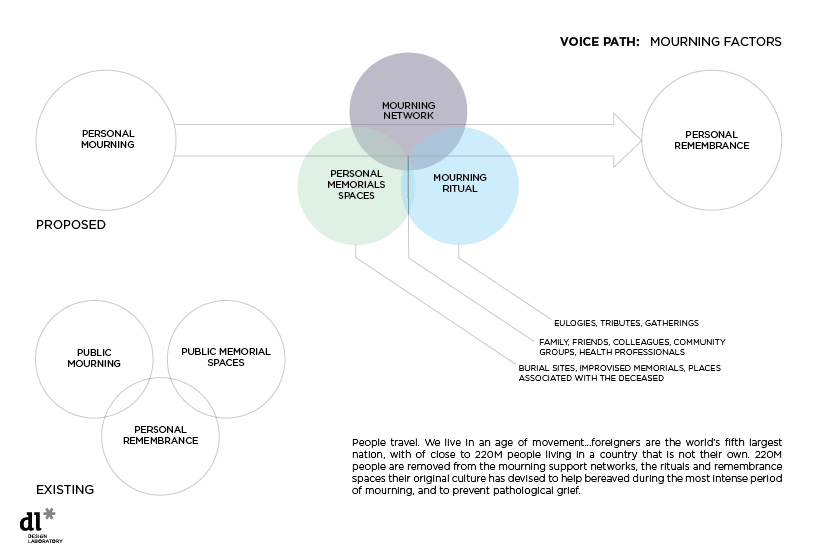
Voice Path by Design Lab from uk
designer's own words:
BACKGROUND
People travel. We live in an age of movement.
We move around the world in search of new experiences and opportunities, growing up in multiple cultures and taking pieces with us wherever we go next. Our friends and family are spread over different cities, countries and continents. We keep in touch via our digital devices and focus less on physical contact.
Foreigners are currently the world’s fifth largest nation, consisting of close to 220M people who live in a country that is not their own. Our design concept aims at the inhabitants, and visitors, of contemporary metropolitan, multicultural cities.
220M people are removed from the mourning traditions their original culture has devised to help bereaved during the most intense period of mourning, and to prevent pathological grief.
There’s no set mourning support system in place within these multicultural urban centres, and hardly any opportunity for sharing of experiences with people in similar situations. There’s no easy access to places of remembrance or mourning, either locally, or to the place of the deceased when not living nearby.
THE SOLUTION
To create a link between where you are and where you need to be via a network for directing messages of mourning and remembrance back to the place of the deceased and the members of one’s mourning support system.
A network of installations provides the opportunity to both listen to incoming messages as well as to anonymously send messages towards a sister installation close to the geographical point of significance.
THE DESIGN
Keeping in mind the varied and multi-cultural population of contemporary urban centres, we have created an adaptable master plan for converting any available and suitable location into a space that offers a therapeutic mourning and remembrance experience.
The installation consists of three elements:
1. A space for listening
2. A space for speaking
3. A space of transition between the two. A space for walking.
The listening space is only defined by the functional requirements: It needs to be contained, have low lighting to focus on the sense of sound, it needs to have broadcasting speakers installed, and it needs to be in suitable spatial relation to the transition- and speaking space. Its capacity should be chosen in relation to comfortably accommodate the projected volume of bereaved. Therefore, the exact shape of the space is not important for its function. Equally, its location is flexible: it could be situated within existing structures, within a custom built shell or even open air, provided the inside of the listening space feels enclosed enough to provide the necessary experience.
The transition space should ideally be situated above the listening space. It is essentially a selectively lit walkway that can be accessed from the listening space and provides indirect lighting for the lower space.
The speaking spaces are accessible from the transition space. Each speaking space is an enclosed, sound insulated structure. The only mandatory interior requirements are a navigation indicator on the floor, as well as four microphones positioned equidistant from the bereaved’s speaking position. Sound delay picked up by the microphone will make it possible to reconstruct the direction the message is spoken in and determine the message’s intended destination.
THE EXPERIENCE
The experience is designed to minimise conscious effort on the part of the participant. There is no excess required action apart from those actually involved in the process of listening, walking, and speaking.
The order in which the mourners interact with the component spaces and in which they make use of the spaces provided is left consciously open. Mourning is an individual process, and and the experience is as openly approachable as possible, equivalent to a therapeutic toolkit that can be used when and as needed.
The bereaved enters the listening space and is immediately surrounded by the voices of other mourners, broadcast to the local installation or along a trajectory the installation lies on. The messages are at lower than speaking volume, forming a constant background sound. Occasionally, parts of messages will be raised to a slightly higher sound level and become understandable. The message and the duration will be determined at random. The mourner is free to interact with other mourners, or to sit and listen for as long as is needed, surrounded by the people who are physically present, but also feeling part of a humanity-wide network of fellow humans in similar situations as themselves.
They can then either leave the installation, or move upwards to the transition space, slowly moving into the light from above while simultaneously leaving the immediate volume cone of the voices being played in the listening space.
The transition space is modelled on the medieval cloister and inspired by the concept of therapeutic walking – an idea going back to examples as diverse as the Australian Aboriginal Walkabout, Aristotle’s Peripatetic School, the medieval monastic cloister, religious processions, recreational hiking. Designed to allow the mourner to think of the deceased, and to reflect on the message they wish to leave to be sent to the destination of their choice, the walkway is selectively lit – infrared sensors detect the presence of a mourner walking and automatically trigger the next overhead light source in front of them, while dimming the one they passed. Selected messages will be raised to a slightly higher sound level and become understandable. They’ll be played at random throughout the walkway, so the mourner can either stop and listen, or carry on walking in thought.
Whenever the bereaved feels ready to leave a message, they enter the next available speaking space. An unoccupied speaking space will have light spilling from around its door, signalling that it is available.
The interior of a speaking space is sound proofed. Its only visible feature is a compass rose made up of the names of possible target destinations on the floor. Finally, the speaking space offers the opportunity to first of all externalise one’s feelings by speaking them aloud whilst in total privacy, as well as the knowledge that the message will actually be sent on a journey towards the intended destination point, creating an indirect bond with the message’s destination (the bereaved, the other mourners, or a place of significance). The mourner positions themselves in the centre of the compass rose, turns into the direction of the deceased, and in their own time simply speaks their message, reads an eulogy, sings a song, holds a long overdue conversation… whatever form of emotional vocalisation is deemed helpful. The voice is picked up by four voice activated, concealed microphones, and the individual volume difference is used to calculate the direction the speaker is facing.
The message is immediately sent in the direction the mourner has been speaking in. The broadcast pattern is a cone rather than line, adding the message to any installation along the message’s path, as well as to the sending and the receiving installation.
The mourner is then free to either remain in the speaking space for a while, to return to the transition space to resume walking, or to descend into the listening space.
People travel. We live in an age of movement…foreigners are the world’s fifth largest nation, with of close to 220M people living in a country that is not their own. 220M people are removed from the mourning support networks, the rituals and remembrance spaces their original culture has devised to help bereaved during the most intense period of mourning, and to prevent pathological grief. 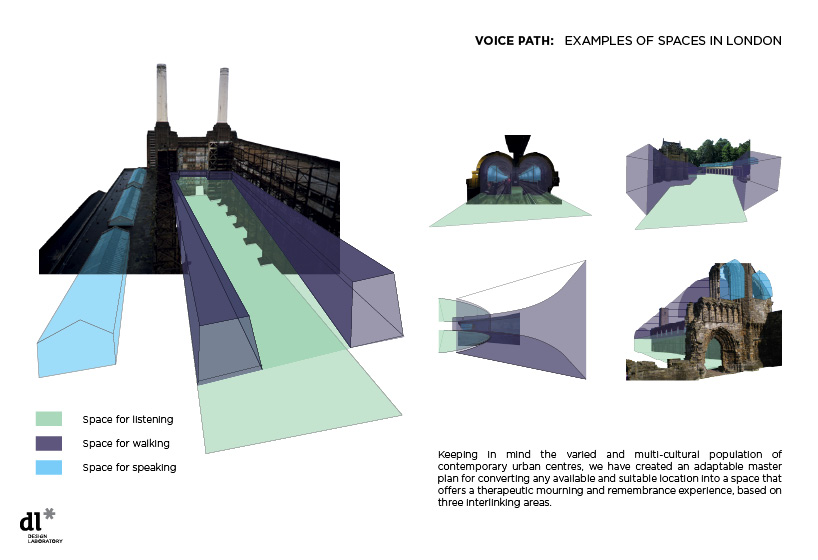
Keeping in mind the varied and multi-cultural population of contemporary urban centres, we have created an adaptable master plan for converting any available and suitable location into a space that offers a therapeutic mourning and remembrance experience, based on three interlinking areas.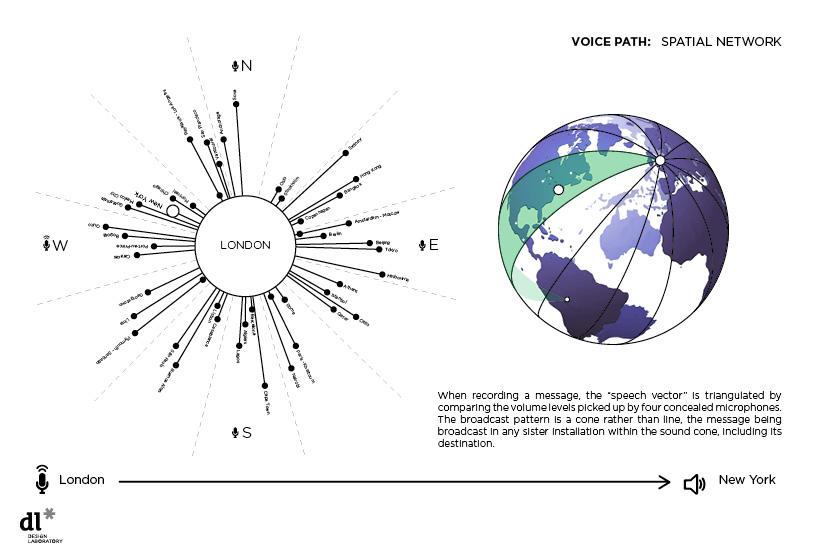
When recording a message, the “speech vector” is triangulated by comparing the volume levels picked up by four concealed microphones. The broadcast pattern is a cone rather than line, the message being broadcast in any sister installation within the sound cone, including its destination.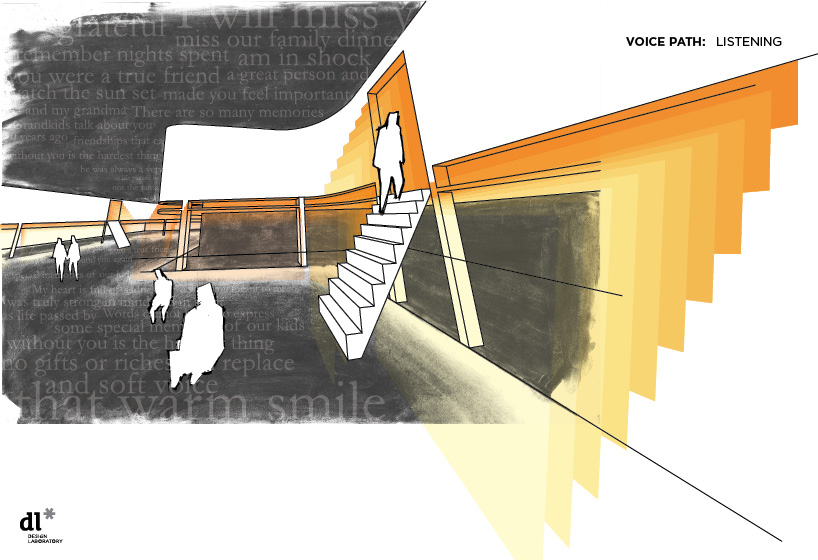
The bereaved enters the listening space and is immediately surrounded by the voices of other mourners, broadcast to the local installation or along a trajectory the installation lies on. The mourner is surrounded by the people who are physically present, but is also part of a humanity-wide network of fellow humans in similar situations as themselves. 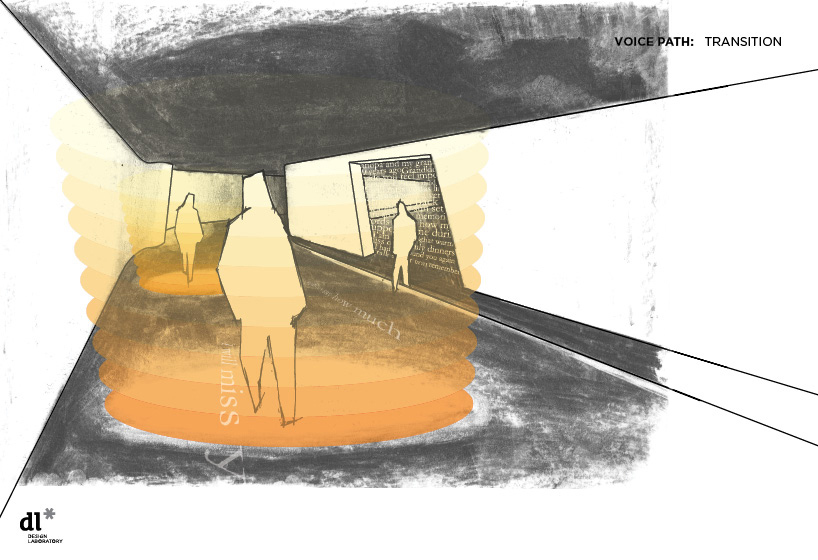
The transition space is modeled on the medieval cloister and inspired by the concept of therapeutic walking. The walkway is selectively lit – infrared sensors automatically trigger the next overhead light source in front of them, while dimming the one they passed. Selected voices are raised to a slightly higher sound level and the the mourner can either stop and listen, or carry on walking in thought.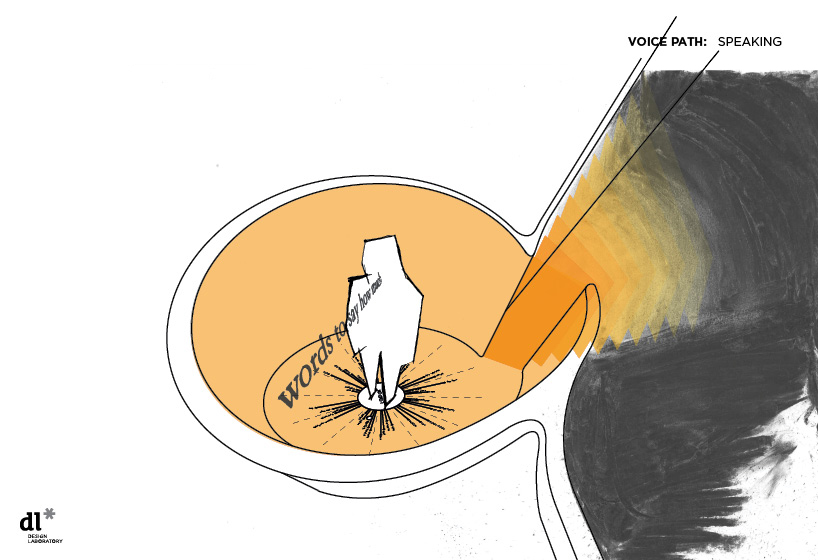
The interior of a speaking space is sound proofed. Its only visible feature is a compass rose made up of the names of possible target destinations on the floor and offers the mourner the opportunity to externalize their feelings by speaking them aloud in the knowledge that the message will actually be sent on a journey towards the intended destination point, creating an indirect bond with the message’s destination.